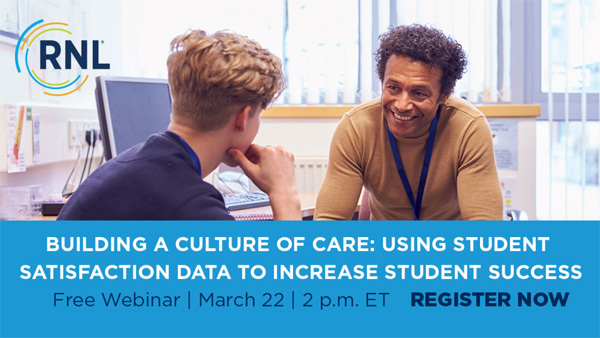student success
Involving Students in Satisfaction Survey Action Steps

Gathering student satisfaction data by administering a survey, such as the RNL Student Satisfaction Inventory (SSI), is a regular assessment activity for hundreds of colleges each year. Institutional research or student affairs determines whether the fall or the spring is the best time to survey students. The results are provided to campus within weeks, clearly identifying areas of strength (areas of high importance to students and that have high student satisfaction) to celebrate as well as challenges (high importance and low satisfaction) to prioritize for improvement.
However, this is the part of the process where campuses often get stuck. They can see what students care about, but then wonder what do we do now?
Who better to turn to than the students? With data that clearly identify the priorities of the overall student population, you can have focused conversations with students to get their ideas for policies or procedures that can be changed, resources that can be added, and areas where better communication may be beneficial.
In recent conversations with SSI client institutions, we heard about the following activities that are taking place to better involve students in using satisfaction data to make improvements on campus.
Cornell College (Iowa): Having the data the student government needs
Angie Bauman Power, director of institutional effectiveness, shared that Cornell’s Student Senate came to her office asking to conduct a student survey to gather data so the group would know what they should be working on. Angie said, “Actually, we already have data you can use to inform your activities.” She shared the most recent SSI results with the Student Senate at the four-year private liberal arts college. They began to identify ways that they could improve student perceptions with the SSI item, “It is an enjoyable experience to be a student on this campus,” along with a few other items related to campus climate. The students were excited to have data to use to guide their activities, and Angie was happy to have their involvement in working to improve the student experience.
Does your student government know that you have gathered data and that you are willing to share it with them?
Madison Area Technical College (Wisconsin): Identifying pain points and the initiatives to address them
At this large two-year public institution, leadership regularly works with the Student Senate to review the data from their Student Satisfaction Inventory administrations.Zong Her, director of institutional research and data management, works closely with Madison College’s every-other-year survey administration. She stated that they shared the results with the Student Senate and pain points are identified from the survey results where the Senate members can target activities and lead initiatives to improve services and awareness for their classmates. The data have been valuable to empower the students to take action and for the institution to see student satisfaction inform improvement efforts year over year.
Is your student senate empowered to implement initiatives to improve the student experience?
College of Saint Mary (Nebraska): Incorporating the Student Senate in the assessment process
Vice President of Academic Affairs Kimberly Allen said the College of Saint Mary, a four-year private institution in Nebraska, is practicing shared governance with students by incorporating the Student Senate in the administration, review, and use of the data. She said it is important to lift up the student voice in decision making. The SSI data help to open the door for the conversations that need to be had with students. She is looking forward to seeing where the practice will take them. Kimberly shared that she is intentionally teaching the entire process of data collection to their students.
Are you listening to your student voices, captured in the data, in the open-ended comments and in the follow up conversations about the results?
Northeast Lakeview College (Texas): Brainstorming with students on improving the student experience
Director of Institutional Research Martin Fortner involves students in all steps of the satisfaction survey process at this two-year public institution near San Antonio. They have student ambassadors in place to encourage fellow students to complete the survey. Student leaders are at the table with campus leadership as the results are initially reviewed and possible next steps are brainstormed. And students are involved with action items to improve the overall student experience. Marty says that student buy-in and involvement are integral to the success of their bi-annual student satisfaction survey administration.
Are you involving your students in every step of your satisfaction assessment activities?
Complimentary consultation on student satisfaction assessment
Talk to our satisfaction assessment experts about how you can easily implement the survey on your campus, including when is the best time to survey and how to get strong completion rates.
Additional strategies to get your students involved with assessment
Here are more ways campuses have shared with us that they are involving students in the satisfaction survey process:
- Have designated students active on social media before and during the survey administration to build awareness and excitement about completing the survey.
- Invite the Student Government Association to partner with the administration in conducting the survey so it feels like students asking students what matters to them.
- Invite students to be a part of “listening sessions” by being visible outside of high traffic areas (the library, student center, etc.) to ask students to clarify what key challenge items may mean to them, such as:
- How can students be made to feel welcome on this campus?
- What does “timely feedback” from faculty mean to you (how timely is timely?)?
- Who do you go to with questions or complaints on this campus?
- When do you want to receive financial aid award information?
- What does tuition being a worthwhile investment mean to you?
- Meet with student groups on campus (not just the student government) to gather their ideas for ways the campus can improve the student experience for top challenge items.
- Establish a student group to work with the institution on next steps with the data. These may be students majoring in a related areas such as Psychology or Data Analytics who could benefit from the experiential learning aspect of being involved with the analysis and next steps.
- Have students be the “face” of the improvements you are making by sharing on social media what the college has done. These students can help you make the case that you are listening to student feedback because you care about the student experience. Closing this feedback loop is critical to seeing satisfaction levels go up.
We know from the research that student satisfaction is positively linked to individual student retention, institutional graduation rates, and institutional alumni giving. Institutions that are regularly assessing student satisfaction with the tools from RNL also have higher graduation rates than comparable institutions who are non-clients. But often the point of difference for institutions are the ones that are doing more than just assessing student satisfaction. They are the ones taking it to the next level by doing something different based on the feedback and guidance provided by their students, both on the survey and in follow-up activities.
What are you doing with your student satisfaction survey results? Let us know.
And if you aren’t regularly assessing student satisfaction and are considering how you can start a new iniative, let us know that as well. My colleague Shannon Cook and I will be happy to help you.
You can also learn more in our webinar Building a Culture of Care: Using Student Satisfaction Data to Increase Student Success. Marty Fortner and Brandi Solar from Northeast Lakeview College will discuss the steps their institution took to use their satisfaction data to improve the quality of life and learning.

